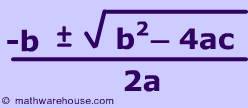1.) Quadratic equation
2.) Completing the square
3.) Factor by grouping
Method 1 - The quadratic equation is:

In the equation you have given, 9x^2 + 3x - 6 = 0, 9 represents a, 3 represents b, and -6 represents c. Simply plug in these three numbers into the equation, simplify, and you will get your x-solutions.
Method 2 - Completing the square
9x^2 + 3x = 6 (Add 6 to both sides)
x^2 + (x/3) = (2/3) (Divide both sides by 9)
x^2 + 2(x/6) = (2/3)
x^2 + 2(x/6) + (1/6)^2 = (2/3) + (1/6)^2 [Add (1/6)^2 to both sides]
(x + 1/6)^2 = 2/3 + 1/36 (Simplify)
(x + 1/6)^2 = 24/36 + 1/36
(x + 1/6)^2 = 25/36
Take the square root of both sides.
sqrt[(x + 1/6)^2] = sqrt(25/36)
x + 1/6 = 5/6 (Simplify)
x = 4/6 = 2/3 (Simplify further)
Method 3 - Factor by grouping
First, multiply the values of a and c together. In 9x^2 + 3x - 6 = 0, a = 9 and c = -6, so multiplying them together will give -54.
Now think, what factors of that number, -54, will sum up to the value of b, which is 3? (Taking the sum means to add). The factors are 9 and -6, because if you add them, you will get 3.
Think of 3x as 9x/5 and 6x/5 (because adding those two fractions together will give you 3x). So we can re-write the equation as:
9x^2 + 9x/5 + 6x/5 - 6
Now group the two pairs, and take out common terms from there. Observe:
(9x^2 + 9x/5) + (6x/5 - 6)
= 9x(x + 1/5) + 6(x/5 - 1)
= 9x(x + 1/5) + 1.2(x + 1/5)
You can see that there are two of (x + 1/5) there, with different constant numbers occurring before it. When you come across this, you must remove the common factors and rewrite as grouped factors:
(9x + 1.2)(x + 1/5)
Overall, method 1 is by far the easiest method to do. You just need to memorize a formula and plug in numbers, rather than do all this work for the other methods.